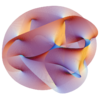Chern–Simons form
In mathematics, the Chern–Simons forms are certain secondary characteristic classes.[1] The theory is named for Shiing-Shen Chern and James Harris Simons, co-authors of a 1974 paper entitled "Characteristic Forms and Geometric Invariants," from which the theory arose.[2][3]
Definition
Given a manifold and a Lie algebra valued 1-form over it, we can define a family of p-forms:[4]
In one dimension, the Chern–Simons 1-form is given by
In three dimensions, the Chern–Simons 3-form is given by
In five dimensions, the Chern–Simons 5-form is given by
where the curvature F is defined as
The general Chern–Simons form is defined in such a way that
where the wedge product is used to define Fk. The right-hand side of this equation is proportional to the k-th Chern character of the connection .
In general, the Chern–Simons p-form is defined for any odd p.[5]
Application to physics
In 1978, Albert Schwarz formulated Chern–Simons theory, early topological quantum field theory, using Chern-Simons forms.[6]
In the gauge theory, the integral of Chern-Simons form is a global geometric invariant, and is typically gauge invariant modulo addition of an integer.
See also
References
- ↑ Freed, Daniel (April 2009). "Remarks on Chern–Simons theory". Bulletin of the American Mathematical Society 46 (2): 221–254. https://www.ams.org/journals/bull/2009-46-02/S0273-0979-09-01243-9/. Retrieved April 1, 2020.
- ↑ Chern, S.-S.; Simons, J. (1974). "Characteristic forms and geometric invariants". Annals of Mathematics. Second Series 99 (1): 48–69. doi:10.2307/1971013.
- ↑ Chern, Shiing-Shen; Tian, G.; Li, Peter (1996) (in en). A Mathematician and His Mathematical Work: Selected Papers of S.S. Chern. World Scientific. ISBN 978-981-02-2385-4. https://books.google.com/books?id=uOfSa0sfJr0C&pg=PA363&dq=%22Characteristic+Forms+and+Geometric+Invariants%22.
- ↑ "Chern-Simons form in nLab". https://ncatlab.org/nlab/show/Chern-Simons+form.
- ↑ Moore, Greg (June 7, 2019). "Introduction To Chern-Simons Theories". http://www.physics.rutgers.edu/~gmoore/TASI-ChernSimons-StudentNotes.pdf.
- ↑ Schwartz, A. S. (1978). "The partition function of degenerate quadratic functional and Ray-Singer invariants". Letters in Mathematical Physics 2 (3): 247–252. doi:10.1007/BF00406412. Bibcode: 1978LMaPh...2..247S.
Further reading
- Bertlmann, Reinhold A. (2001). "Chern–Simons form, homotopy operator and anomaly". Anomalies in Quantum Field Theory (Revised ed.). Clarendon Press. pp. 321–341. ISBN 0-19-850762-3. https://books.google.com/books?id=FC_DRRUHFXEC&pg=PA321.
 |

